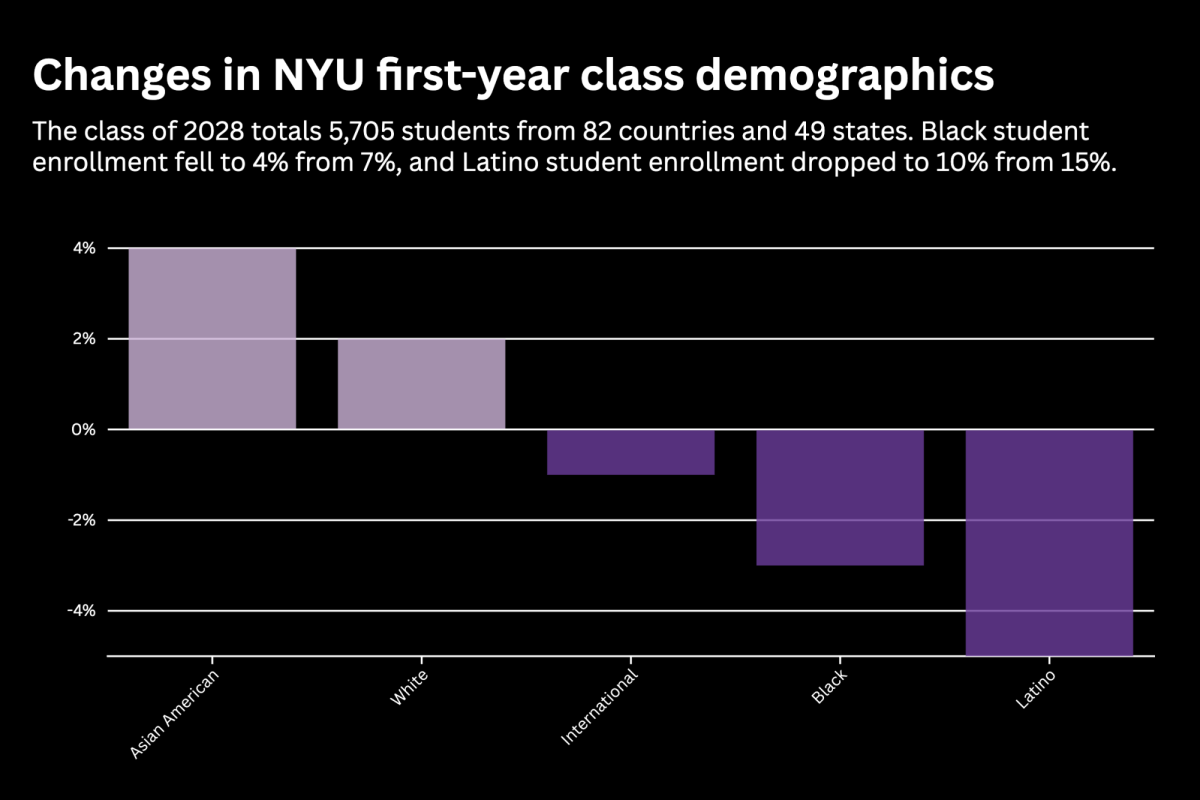NYU saw a sharp drop in enrollment from underrepresented minorities in its first class of students admitted after the U.S. Supreme Court’s ban on affirmative action last year — a trend the university said was “concerning” in a Wednesday press release.
The data for NYU’s class of 2028 shows that “historically underrepresented minority groups” — which the university says include people who identify as “Black, Hispanic, Native American and Hawaiian and other Pacific islander” — constitute 14% of the first-year student population, down from 23% of its previous class. Black student enrollment fell to 4% from 7%, and Latino student enrollment dropped to 10% from 15%. The university did not provide enrollment figures for Native American and Hawaiian or other Pacific Islander students.
In its press release, NYU said the changes were “not unanticipated” and attributed them to the Supreme Court’s 2023 decision to strike down race-sensitive college admissions practices. The university had criticized the ruling, calling it “a step backwards” in a letter to the NYU community.
“NYU wants a student body that thrives on difference,” President Linda Mills said in the release. “We will — we must — continue to innovate on and expand educational opportunities for students of all backgrounds and experiences.”
In a June 2023 statement made in anticipation of the ruling, NYU’s Office of Global Inclusion, Diversity and Strategic Innovation said research and data demonstrate that “race as a lived experience continues to ‘matter’ regarding access and opportunity.” It added that the university’s administration had planned to work with its Office of General Counsel to continue implementing values on diversity, equity and inclusion “through legally permissible means.”
The university reported that the proportion of first-generation college students remained at 21%, while the percentage of Pell Grant-eligible students rose to 23% from 19%. The class of 2028 is the first group of students to benefit from the NYU Promise, which waives tuition costs for undergraduate students admitted to the university’s Washington Square and Brooklyn campuses from households with an annual income of less than $100,000.
Alongside the decline in Black and Latino student enrollment, the percentage of Asian American first-years rose to 27% — up from 22% last year — and white student enrollment increased to 23% from 21%. The proportion of international students dropped to 26% from 27%, with the class totaling 5,705 students from 82 countries and 49 states.
The Supreme Court’s 2023 decision followed two cases filed against Harvard University and the University of North Carolina at Chapel Hill in 2014 by Students for Fair Admissions, a nonprofit that argues race-sensitive admissions policies place white and Asian American applicants at a disadvantage.
Other universities have reported similar declines in first-year enrollment among Black and Latino students, including other private institutions in New York, such as Cornell University and Columbia University. Historical instances of affirmative action bans, such as those at the University of Michigan in 2006 and in California’s public universities in 1996, have led to reduced enrollment for minority groups.
Prior to the ruling, NYU categorized applicants’ racial and ethnic identities as “considered” in its annual Common Data Set, which details enrollment, class demographics and other university data — information that has not yet been published for this year. The university also removed its “Why NYU?” essay and replaced it with an optional diversity-related prompt for the 2022-23 admissions cycle.
“While the legal landscape changes, our values do not,” Mills said. “We must innovate — while always complying with existing law.”
A university spokesperson did not immediately respond to a request for this year’s Common Data Set.
Contact Krish Dev at [email protected]























































































































































